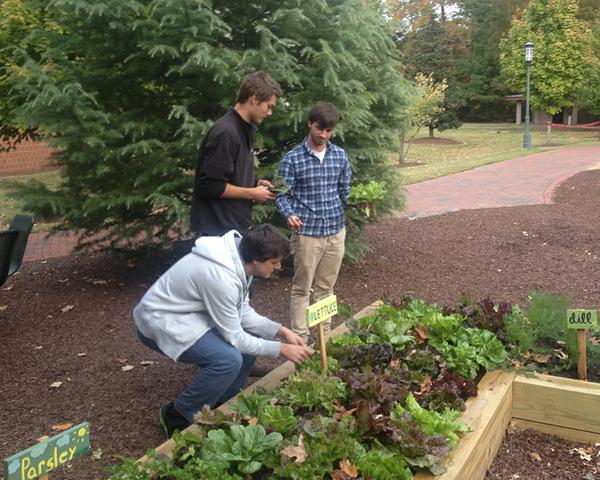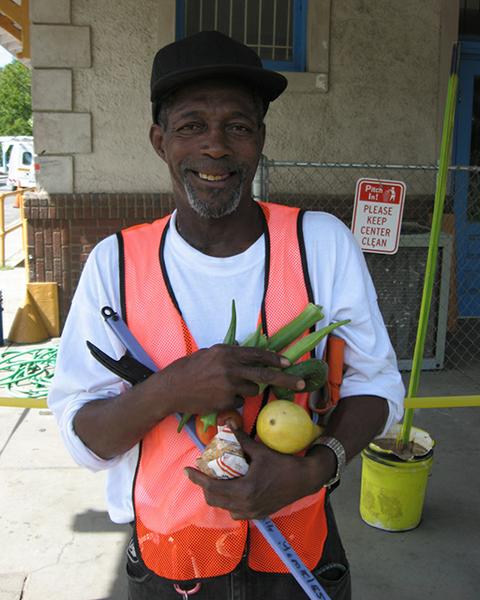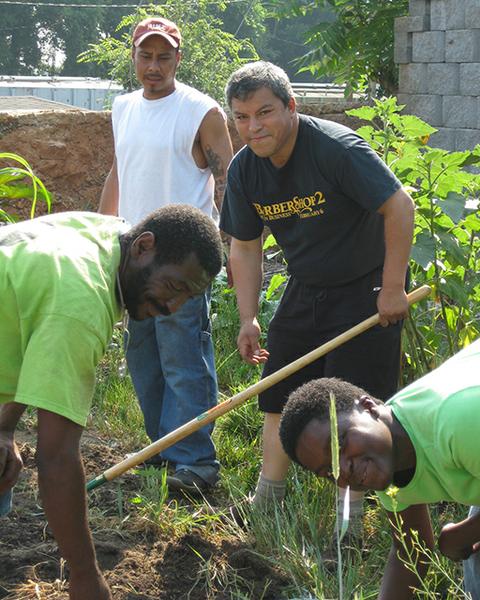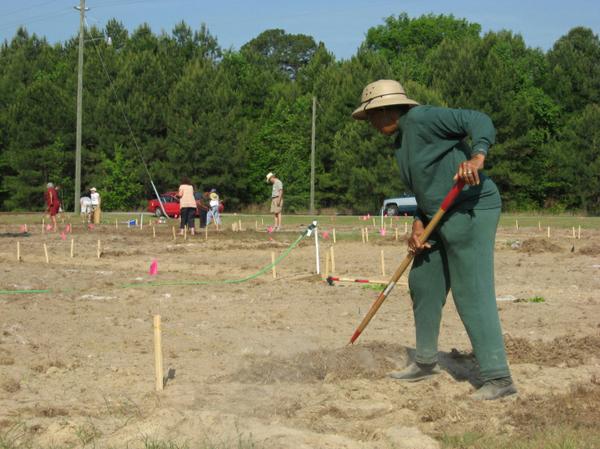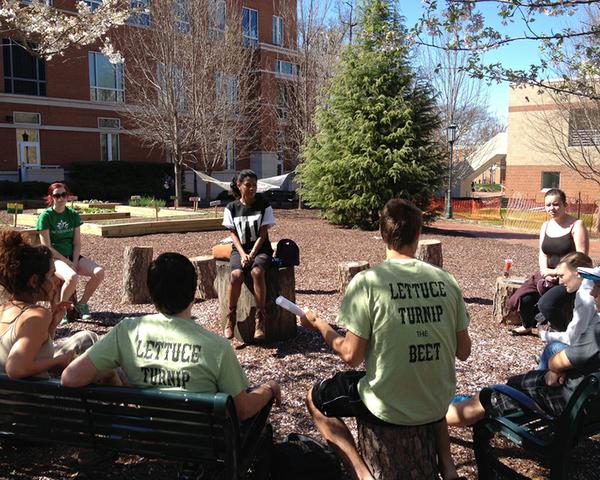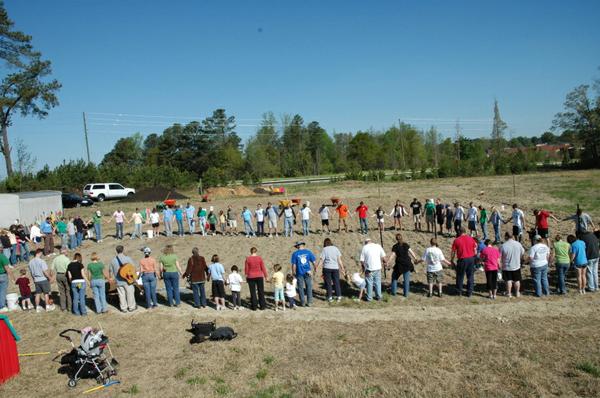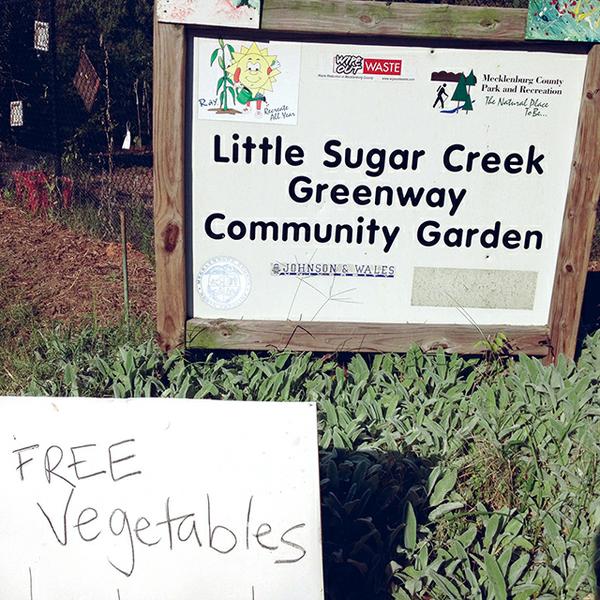The best way to build an effective community garden organization is to engage and empower the gardeners. During the first year or two, the original garden team continues to play a vital role. After opening day, however, the team has a new goal—helping the garden become self-sustaining, where gardeners successfully manage day-to-day operations on their own.
Making Decisions
Resist the temptation to set major policies and make important decisions without including gardeners and other garden stakeholders in the decision-making process. Being inclusive takes more time, but it pays off with better ideas, greater buy-in, and a stronger garden.
Establish workable, practical ways to give everyone a say, but try to move quickly to peaceful agreements. Whenever possible, seek consensus solutions rather than relying only on majority rules votes. Make sure each gardener feels respected and understands that others value her or his ideas, concerns, and suggestions.
Leadership, Responsibilities, and Roles
Successful community food gardens often have an informal structure that maintains the cooperative spirit of the original garden team. Responsibilities and roles are frequently blurry in any community garden, even after a garden has elected officers, named chairpersons, and set up committees. It is important, however, to empower those who have been assigned a responsibility. Give garden leaders, committee chairs, and volunteers a chance to succeed on their own. If intervention or assistance seems necessary, be respectful and take action in a diplomatic, problem-solving way.
Garden Coordinators and Head Gardeners
Although the title for the person who manages the garden may differ from program to program and garden to garden, most successful gardens have someone empowered to make decisions, answer questions, and coordinate resources. Two commonly encountered terms are garden coordinator and head gardener. These roles overlap a good deal, but for simplicity’s sake this manual will make a distinction.
A garden coordinator is usually a paid employee, or occasionally a trained volunteer, who assists a community garden with organization and management and serves as a liaison between the sponsor and gardeners. Paid garden coordinators normally work with a number of gardens.
Garden coordinators are frequently the people who oversee assigning plots and maintaining the waiting list. They troubleshoot problems from mediating gardener disputes to reassigning abandoned beds. They may also schedule and chair major meetings, facilitate at workdays, and coordinate resources and services, such as compost, tilling, and contributions of tools and plants. Conscientious coordinators even pitch in to help with maintenance and to help others in the garden.
The closely related role of head gardener is similar, with many overlapping responsibilities. However, for purposes of this manual, head gardener is more often a volunteer position that is normally limited to a single garden. Most often, an experienced gardener holds this position. While it is usually an unpaid position, dues are sometimes waived for head gardeners. Garden coordinators with multiple sites often delegate routine management tasks to a head gardener for each garden.
Committees
The Steering Committee. A steering committee or leadership committee of three or more members, similar to the original garden team, can help keep the garden running smoothly by working closely with the garden coordinator, the head gardener, or both. In some cases, the steering committee serves in the coordinator or head gardener role.
The steering committee may assume many leadership, decision-making, and organizing functions, particularly in the absence of a paid garden coordinator. When the steering committee manages the garden’s membership, waiting lists, and dues, it is essential to find reliable volunteers to handle these important responsibilities and maintain accurate, up-to-date records.
A steering committee may be composed solely of gardeners or be a mix of gardeners and representatives from the garden’s sponsor, other support agencies, and the neighborhood. The committee frequently includes members of the original garden team. The steering committee is often informal and self-selected, consisting of those gardeners who step forward to deal with larger garden issues. Some gardens take a more formal approach and create their steering committees by electing traditional officers, such as president, vice-president, secretary, and treasurer, and automatically naming them as steering committee members. Members of the steering committee should be ready to work with gardeners, sponsors, and neighbors who have questions and concerns, as well as members of the general public, the press, and public officials who are interested in the garden.
Task Committees and Project Teams. Task committees form to handle responsibilities such as mowing paths, creating and managing a garden website, and keeping the tool shed clean and organized. A gardener or volunteer with a special interest or expertise in a given area makes an ideal chair for a task committee. The task committee that handles maintenance and keeping up the garden’s appearance is especially important. If a maintenance committee becomes a “committee of one,” the amount of work may overwhelm a single volunteer.
Sometimes task committees form project groups to handle a specific project, such as building a gazebo or shed, handling arrangements for a fundraising activity or social event, or applying for a grant.
Community Volunteers
Community volunteers from organizations such as civic groups, schools, and places of worship can help accomplish large, demanding tasks such as clearing trash from the site, spreading mulch on paths, and general cleanup and weeding.
Community volunteers can contribute much more than simple labor. For instance, NC State Extension Master GardenerSM volunteers have served as garden mentors and have coordinated tours of community gardens in some counties.
Youth volunteers have great potential. For example, at a community garden for the homeless at Charlotte’s Urban Ministry Center, Eagle Scouts have built stairways, pathways, and arbors, greatly improving the garden at no expense to the gardeners or the garden sponsor.
Make sure all community volunteers have a positive experience at the garden and know that they are appreciated and respected. Thank them sincerely for their work and contributions, and write them up in the newsletter. Never underestimate the incentive value of a basketful of fresh vegetables.
Guidelines and Rules
Clearly written guidelines or rules provide a straightforward set of procedures, expectations, and responsibilities for gardeners.
To create guidelines, review the garden’s goals, consider examples, and borrow good ideas from established, successful community food gardens.
Discuss a draft version of proposed guidelines with gardeners and incorporate their comments and suggestions before making the guidelines final. Evaluate and revise guidelines on an ongoing basis.
Keep garden guidelines simple and use common sense. Gardeners may be inclined to ignore guidelines that are too persnickety, controlling, or lengthy. A simple, single page of bullet points will suffice. Share the rules with gardeners, post them in a central location, and make sure everyone involved in the garden understands them.
Working With Gardeners
Motivated and engaged gardeners are a community garden’s most important harvest. They are people who bring positive changes to the communities where they live. There are many ways the garden’s organizational system can recruit new gardeners and keep current gardeners committed and energized.
Recruiting gardeners
Gardener recruitment starts even before the garden exists, beginning with the first informational meetings in the community. While recruitment is most intense during the start-up period, it continues on an on-going basis to fill vacancies in the garden. A website and Facebook page are good recruiting tools, as are more traditional techniques, such as special events, public meetings, and flyers.
The Application
Establish a clear application and selection process for assigning plots in a plot garden. Use a similar process to enroll members of a cooperative garden. An application form should record the applicant’s name, contact information, emergency contact, and other relevant information, such as organic gardening preference and gardening experience. Make sure applicants receive valid contact information for the garden coordinator or another official garden representative. A website can make the application process convenient for those with access to computers.
The Selection Process
When applicants exceed available spaces, the garden must decide on a selection method. One option is first-come, first-served, based on when applicants file their application. Another option is a lottery, where applications are collected for a set period and then names are randomly selected to assign plots. Applicants who do not get a plot are put on a waiting list.
Garden sponsors or the garden team may want to recruit selectively for all or some plots, choosing gardeners on the basis of ethnic group, family size, age, place of residence, financial need, or another factor. Organizers may also want to reserve one or more plots for resource people, such as the garden coordinator, head gardener, or an Extension Master GardenerSM volunteer.
Letter of Agreement
After receiving a plot assignment, each gardener should sign a letter of agreement stating that she or he will abide by garden guidelines, participate in workdays and meetings, and pay designated dues.
A letter of agreement helps ensure that gardeners understand expectations from the beginning. The agreement should plainly state all requirements, timelines, and consequences for non-compliance. The garden coordinator or membership committee should keep a file for each gardener containing the signed letter of agreement and completed application form.
First Plot Visit
Each new gardener should be invited to the garden to meet on site with the garden coordinator, a garden team member, or an established gardener. Together, they can visit the gardener’s new plot for the first time, and the new gardener can sign the letter of agreement, check contact information, and pay dues. This offers a chance to discuss the garden informally and answer questions. The gardener should receive a duplicate of the letter of agreement, a copy of the garden guidelines, a roster, and a plot map.
The Waiting List
A waiting list tracks people interested in joining the garden. Be careful not to promise anyone a plot or place in the garden when none are available. The person in charge of the waiting list must keep an accurate, regularly updated count of the number of people on the list and the probable wait time before a plot is available. Let people on the list know this information when they sign on. Also tell them about nearby community gardens with available spaces.
Avoid allowing a gardener to cut in ahead of others on the wait list. Some applicants are very eager and will call and email incessantly. Resist the temptation to simply give someone a spot.
Renewing Plots
Automatically extending a gardener’s right to work a plot from year to year provides a powerful incentive for gardeners to improve the soil and stay involved in the garden. Successful gardeners invest a good deal of money, effort, and hope in transforming their plot into a fertile and productive garden space.
Look for ways to expand the size of the garden to provide more spaces and to help start additional community gardens to accommodate everyone in the community who wants a garden space.
Multiple plots
Families will sometimes take over large areas of gardens—or whole gardens in some cases—by taking out plots in different family members’ names. Some gardens limit families to a maximum of two plots. However, active gardeners with growing experience and sufficient time and energy can successfully manage a 1,000 square foot gardening area without major difficulty. Consider creating “large plot” gardens for these experienced gardeners.
Once opening-day excitement fades, some plots may become unoccupied or neglected. Establish guidelines for reclaiming and reassigning these plots. Active gardeners are quick to ask for vacated plots, but consider if gardeners on the wait-list might also be interested. Some gardens temporarily assign second plots through the end of the growing season. Make the rules clear up front; once gardeners pay for and receive plot assignments, they often will be reluctant to give them up and may even become emotional, even after only a short time.
Meetings, Work Days, and Gatherings
Meetings, workdays, and social gatherings are all important for an effective community food garden. Working together to solve problems and accomplish tasks can strengthen community leadership and increase social capital. For further discussion, please see chapter 7, Management.
Experts Available
Apart from workdays, the garden coordinator, head gardener, and skilled gardeners can schedule a regular block of time each week to be on site to answer questions and make suggestions. Gardeners may prefer to work on their plots at this time, knowing they will find others in the garden. These times offer a good chance to hold informal discussions and share information.
Celebrations
Try to organize at least one or two special events during the year when gardeners can gather to enjoy their garden and socialize. There are plenty of potential excuses to celebrate—signing the lease, planting day, first tomato harvest, summer solstice, spring and fall equinoxes, and Earth Day, to name a few.
Inviting the larger community to a celebration is an excellent way to build good community relations. Host regular open houses to give the public the opportunity to visit the garden, ask questions, and ideally, get involved as a supporter, volunteer, or gardener. Events and celebrations can generate invaluable media opportunities, attract interest and partners, and promote relationships and goodwill with the community.
Communication
There are two aspects to communication. First, within the garden, gardeners must be able to stay informed and share their questions and opinions. Indispensable tools for communicating within the garden include email, the telephone, a garden bulletin board, and face-to-face contact. Second, the garden must be able to communicate effectively with the larger community, including sponsors.
Email, Newsletters, and Phone Trees
These days, it is tempting to handle most internal communication by email. Some gardens have set up listservs, which are simple electronic discussion groups using email. Others rely on Facebook. Others send out an electronic newsletter via email. However, it is also vital to include gardeners who communicate by telephone and who may not even own a computer. A simple, short, printed monthly newsletter can cover the high points, and an old-fashioned phone tree is helpful for reminders and last minute information.
Web Presence
Websites, blogs, and social media network pages (such as a Facebook) are all useful tools for communicating with existing gardeners, recruiting new gardeners, and engaging volunteers, partners, sponsors, and the public. However, a website or Facebook page filled with outdated or inaccurate information is worse than having no web presence. Review the on-line community garden directories by North Carolina Community Garden Partners and the American Community Gardening Association for links to garden websites, blogs, and social media to visit for ideas.
|
Potential Components for a Garden Website Key Elements
Optional Elements
|
The Garden Bulletin Board
A garden bulletin board is a low-tech but valuable tool for communicating with visitors, community members, and gardeners alike. Post important meetings, special events, work times, and accurate contact information for the garden coordinator or head gardener. If the garden newsletter is distributed electronically, a printed copy of the latest issue can be posted on the bulletin board. Consider posting identification and management information for garden pests currently causing problems in the garden.
Places for Conversation
Be sure to maintain comfortable places for large and small groups to gather and talk in the shade.
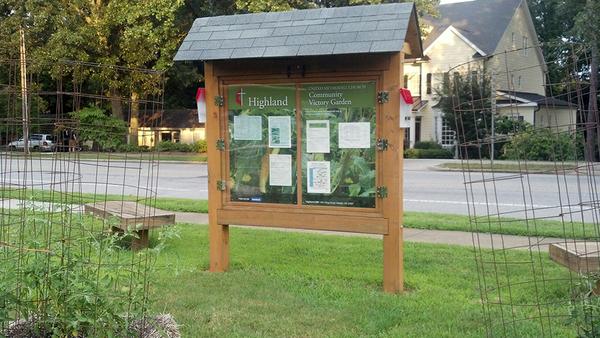
Lucy Bradley CC BY-SA 4.0
Expanding Community Outreach
Communication with the larger community segues into publicity, public relations, and community organizing—each a discipline in its own right—with important implications for fundraising and gaining public support. The American Community Gardening Association’s Cultivating Community training includes an excellent discussion of larger communication issues.
Signs
An attractive sign with the garden’s name and reliable contact information is an important communication tool. More detailed signs explaining what a community food garden is and how to enroll are also very helpful. Additional “how-to” signage is also helpful throughout the garden, such as a sign describing what goes where in the compost piles.
Press Releases
The garden may want to occasionally send out a simple press release to a list of local media to share information about its classes, events, and volunteer service opportunities. Helping with publicity and press releases is a tailor-made role for a gardener or volunteer with experience working with the media. Don’t forget to share notices with neighborhood associations, houses of worship, and other local organizations, and post copies on bulletin boards at coffeehouses, libraries, recreation centers, and other locations throughout the community.
Factsheet
Prepare a one-page factsheet to provide basic information about the garden, the application process, and what membership entails. The garden’s website can also feature this information. An expensive and fancy brochure is nice but not necessary.
Publication date: Aug. 10, 2017
AG-806
Other Publications in Collard Greens and Common Ground: A North Carolina Community Food Gardening Handbook
N.C. Cooperative Extension prohibits discrimination and harassment regardless of age, color, disability, family and marital status, gender identity, national origin, political beliefs, race, religion, sex (including pregnancy), sexual orientation and veteran status.

